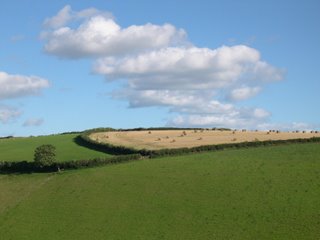
Ben was by the Dairy at 8:00 in order to show me how to do the Sunday routine. It involves scrubbing moulds, turning cheeses, labeling them and putting them away to rest. Then moulds are transferred into barrels full of a mild acid in order to de-scale them. Some moulds go in one barrel, others get rinsed and go into another. I'd better make sure I know which is which, because next week I fly solo.
Ben took off before 9:00AM to go to the Tavistock Cheese Festival. I was left to my own devices. I had to do wash the white lab coats for the week and then I was free to go and explore the area.
I had picked up some leaflets at the Totnes Tourist Information office on Thursday. One of them listed guided walks around the South Hams area (this part of Devon.) A walk was leaving at 10:30 from the TI. It was called Totnes' hidden highways, lead by Valerie Belsey. Ms. Belsey published a book called "Exploring the Green Lanes of the South Hams." This three mile walk followed old paths that run between the hedgerows, and have since the Saxons used Totnes as a trading center. There were twelve of us and two dogs on the walk. Valerie explained the that these lanes were used by drovers, taking their livestock to market, as well as peddlers, soldiers, and thieves. Large oak trees were used as landmarks along the paths because they are visible above the hedgerows. The paths definitely go from tree to tree. At the farthest point on our walk, we stopped and took in the panoramic view of Totnes, the castle at Berry Pomeroy, Hound Tor on Dartmoor, and several other villages. We were taught how to date a hedgerow. Count the number of plant species in a thirty yard stretch of hedge. Each plant species equals 100 years in age. In our demonstration section we counted seven different plants. This hedge was probably 700 years old. The lanes are sometimes paved roads, sometimes unpaved tracks, or part of developed trails. They are all over the countryside, especially near market towns like Totnes. We ended our walk at 12:30 back at the TI. Just in time for lunch! It's Sunday, so most places are closed. I found a pub called the Barrelhouse that was open. One BLT and cuppa tea later, I felt refreshed and ready to head back to the dairy. It was bright and sunny. The perfect weather to take an afternoon nap.
I picked up a booklet at the TI the other day. It's called "Clotted Cream" by Carolyn Martin. It is thirty-two pages about the history, use of, and preparation of clotted cream. Nothing goes better with pie than a large dollop of clotted cream. It has a fat content of over 55%! It's heavier that heavy whipping cream. It's thicker, too. If made in the traditional way, it is left to sit overnight in a shallow pan and then cooked gently in a water bath for a couple of hours or until a thick crust forms. I have been resisting bringing some home. It is so good on fresh berries. Channel Island milk is recommended. This means getting milk from Jersey or Guernsey cows. 
Wednesday, August 30, 2006
Walking the Green Lanes
Posted by
Sairbair
at
8:50 AM
![]()
Labels: Ticklemore Cheese Devon England
Subscribe to:
Post Comments (Atom)
No comments:
Post a Comment